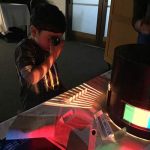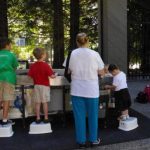Blog
The Science of Bubbles
Bubbles! What makes them so enticing?
Bubbles are something so common that most people have interacted with one; either grabbing a bubble wand and creating giant bubbles yourself, making a bubble bath, or encountering a stray bubble (like the one that floats around when washing the dishes).
We ask, how are bubbles formed? Why are loose bubbles spherical in the air? Today, we’re getting into the science of bubbles!
The Science of Bubbles:
All you need to make a bubble is soap, water, and air…sounds pretty simple right? But the way bubbles are formed is actually a bit more complicated than that. You see, a bubble is a layer of water that is being sandwiched together by two layers of soap. This pairing creates a pocket of air in the middle which allows the bubble to form (and to float).
The reason soap molecules create this kind of arrangement is because of a property where the “head” of the soap molecule is hydrophilic (meaning it wants to touch water) and the “tail” of the soap molecule is hydrophobic (meaning it doesn’t want to touch water). This is how the air is trapped inside.
Molecules try to move from areas where there are a lot of the same molecule to where there are less (this is to maintain equilibrium). As such, a bubble then will pop when it touches your finger because the water molecules are attracted to the dry surface of your finger; the water pulls toward your finger and away from the soap molecules, thus breaking their formation… and popping the bubble!
Even if you stretch a bubble out into a unique shape, once it leaves the bubble wand it’s going to become circular…
Why do bubbles become circular once in the air?
This is because a sphere is a shape with the lowest amount of surface area, which means it takes very little energy to form. It’s the “natural” form to take in still air, you could say.
Thank you for your curiosity! A little much to take in? Remember, you don’t need to know the exact science of something to be able to experiment with its properties and enjoy the investigative experience! If we’ve piqued your interested in bubbles, make sure to visit CuriOdyssey on Sat & Sun, June 23-24th for Bubbles & Rainbows from 10a-3p.
#CuriOdyssey #BubblesAndRainbows
~~~
Find out more! Info & Photo References:
- https://www.thoughtco.com/bubble-science-603925
- https://scienceworld.ca/resources/activities/catch-bubble
- https://wonders.physics.wisc.edu/science-of-bubbles
Edited by Adele R.
Join the CuriOdyssey Community
LOCATION
1651 Coyote Point Drive
San Mateo, CA 94401
Ohlone Land Acknowledgement
650-342-7755
[email protected]
CuriOdyssey is a 501(c)(3) non-profit, Tax ID 94-1262434







